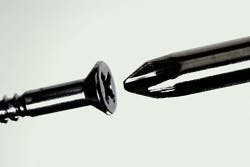What's the Difference Between Thread-Forming and Thread-Cutting Tapping Screws?
Tapping screws form mating threads in materials they are driven into. There are two basic types: thread forming and thread cutting.
The thread-forming screw displaced material around the pilot hole so that it flows around the screw’s threads. These screws generally are used when large stresses are needed to increase resistance to loosening. Because no material is removed, the mating part creates a fit with zero clearance. They usually do not need lockwashers or other types of locking devices to prevent loosening.
Thread-tapping screws have cutting edges and chip cavities that create a mating thread by removing material from the part they are driven into. The screws’ cutting action means torque needed for insertion is low. The screws are used in materials where disruptive internal stresses are not wanted, or when it takes to too much driving torque to use thread-forming screws.
In general, tapping screws permit rapid insertion because nuts are not used and access is required from only one side of the joint. Mating threads created by these tapping screws fit the screw threads closely, and no clearance is needed. The close fit usually keeps the screws tight even when subject to vibrations.
Taping screws are usually case hardened and have tensile strengths of at least 100,000 psi with relatively high ultimate torsional strengths. Tapping screws are used in steel, aluminum, die-castings, cast iron, forgings, plastics, reinforced plastics, and resin-impregnated plywood.
Tapping screws are available with either coarse or fine threads. Coarse threads should be used with weak materials. Fine threads are recommended if two or more full thread engagements must be above the cutting slot, but the material is not thick enough to allow two full threads of coarse threads.
